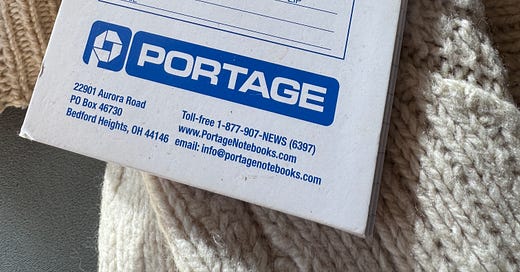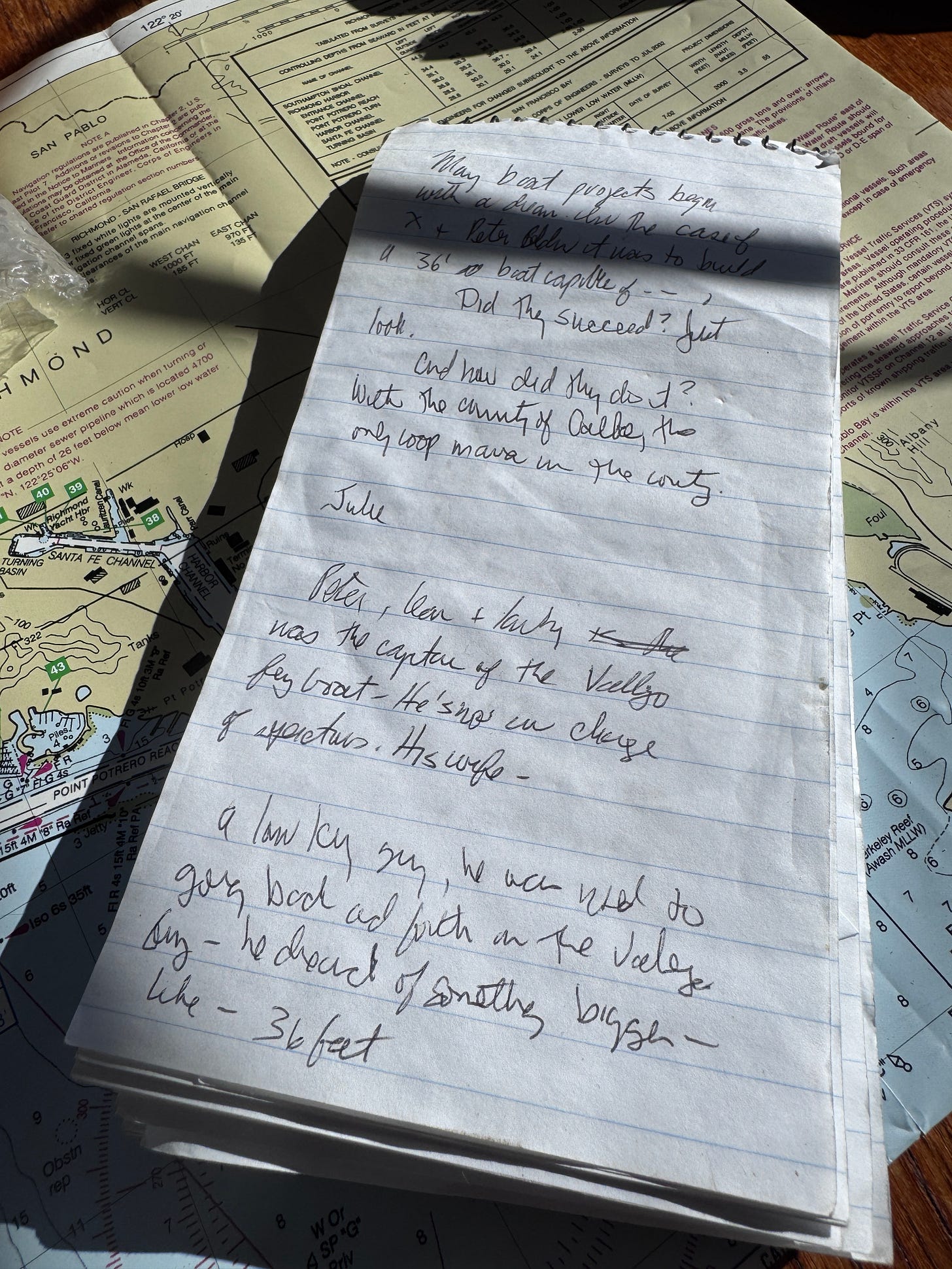In his Princeton “factual writing “ class at Princeton, since 1974 author John McPhee always began with this mantra. He scribbled it in chalk on the blackboard- a quote from Cary Grant:
“A Thousand Details Add Up to One Impression.”
Indeed it does. But how do you remember all those myriad details when you’re working on a story? Notes. Handwritten.
McPhee also counseled, “ Whatever you do, don’t rely on memory.”
I confess. I love reporter’s pads. They fit so neatly in the palm of your hand and the pages flip nicely. You can even wrap a rubber band around them to get to the page where you left off. In fact I’ve kept all of my pads from different assignments squirreled away in a bin in my storage unit.
A smart phone voice recording can help but the old stand-by, a reporter’s notebook, does the job best. In his book, Draft No. 4, McPhee writes that he draws a square box around details that he might use later in his story. McPhee advises that if you’re going to use a voice recorder, don’t make it your first choice, - “it should be more like a relief pitcher.” McPhee has written thirty books so he should know.
McPhee preaches about bringing the characters in a story to life with small details. Following his lead, I scribbled these notes on my reporter’s pad for this recent interview for “Slow Burn”, a story assigned by Passagemaker, a yachting magazine.
I was interviewing Peter Belden in the pilothouse of his boat Kama Hele, the subject for my feature, Slow Burn. Kama Hele is a gorgeous vessel that Peter and his wife built almost entirely by themselves while Peter was working as a ferry boat captain in San Francisco Bay. I later transcribed the interview using the iPhone app. In my reporter’s pad I jotted down “ …used to going back and forth on the Vallejo ferry, he dreamed of something bigger.” That sentence didn’t make it into the story however, as the word count needed reducing. And though I noted that Peter was “lean and lanky” I cut that too. Too cliched. He isn’t lean. And in some other notes I scribbled “ Walt Whitman’s Crossing Fulton Ferry”, to remind myself to re-read this master wordsmith’s iconic piece of poetry which never ceases to inspire me.
A former tabloid journalist, Whitman kept extensive jottings which often provided specific detail later on in his poetry. Below in his notebook, he reminds himself to include “the scenes on the river as I cross Fulton ferry”. These lines , “A hundred years hence others will see the flow, of the river…” are included in the final draft of his poem. On that same page he has noted the more mundane, an address for a Mr. A.J. Davy who lived at 137 Spring Street.
I’m no John McPhee or Walt Whitman, that’s for sure. I began my career working as a photojournalist, later becoming a video-journalist. I only wrote in order to get a photo or video assignment. But these days, photo assignments are few and far between as that industry has collapsed. Everybody is a photographer and give their content away. Editors can purchase royalty-free photo packages from Getty for peanuts. However, lucky for me, along the way, I learned to write scripts for my video stories and magazine articles. But it’s never easy, the act of writing a coherent story.
Notes help big time. When I’m working on a story, I review my them in my reporter’s pad, trying to decode my scribbling. I will mark a passage, fact or detail in my notes with a star, if I think is important to remember or include in my story.
Whitman didn’t use stars or underlining. Instead he often drew a pointing finger. Below, he reminds himself to “avoid all the intellectual subtleties,” and “withering doubts”…“bloated hopes” and “unrequited loves”, which I suspect is he perceived as trite.
Below in another page from his notebook, preserved in digital form of the Library of Congress, he notes different adjectives, verbs or descriptions that perhaps he wanted to remember to use later. They include “greedy, grudging, adulterous, blabbed, resented, the cheating look”, and finally “guile, lust, hot wishes I dared not speak.” Wow.
Take a look a look at the content in Whitman’s notebooks in the collection of the Library of Congress, found in BOX 37-38 REEL 24:
Notebooks, 1855-1884 Notebooks and handmade booklets formed by pages either tied or pasted together and containing thoughts and ideas written in the form of personal and literary jottings, including trial lines and titles for poems, clippings, manuscript fragments, and names and addresses. Reference notes and synopses of studies conducted by Whitman on topics such as human rights, slavery, religion, philology, language and grammar, and classical studies are also included. - Library of Congress
McPhee, like Whitman, throws a veritable kitchen sink’s worth of details into his vivid “creative non-fiction” stories published in The New Yorker that were often tens of thousands words long and later became books. He won the Pulitzer Prize in 1999.
“When I’m making notes, I throw in a whole lot of things indiscriminately, much more than I’ll ever use, but even so, I am selecting. Later, in the writing itself, things get down to the narrowed choices. It’s an utterly subjective situation. I include what interests me and exclude what doesn’t interest me.” -John McPhee, Draft No. 4
You never know what you will use from your jottings, ruminations, observations or day dreams. Author Patricia Lockwood wrote about her her muse, her notebooks, in an article that was published in the print edition of the New Yorker’s November 28, 2016 issue with the headline “Quote Marks.”
Now I am at the coffee shop, in a metal chair, bent over a table. Next to me is a woman and her barrel-chested dog, who thumps the coarse plume of his tail and continuously worries a mysterious black curve. “It’s a piece of antler,” the woman explains. “He carries it with him everywhere. He thinks it means something.” I type that into my notes and return to my book, Clarice Lispector’s “The Hour of the Star.”
For my part, when I find myself staring off into space, after hitting a block while writing and then begin to toss in too many adjectives and abstractions, it’s often because I didn’t take enough notes.
As Tom Corfman notes in his post, How to Make Your Writing Like a Flashlight: 9 Writing lessons from The New Yorker Staff Writer John McPhee, “Problems in writing stem from holes in the reporting, when we resort to adjectives because we don’t have the details, the color we need to paint a picture.”-Tom Corfman
You can buy a three or 24-pack of “The Portage reporter’s notebooks” on Amazon which the Portage tells us “ has been the staple in journalism since 1955. For more than 50 years we have served the newspaper industry and have a trusted reputation offering outstanding products and tremendous value.”
Take it from me, the heft is right for these pads and there’s no better investment.













